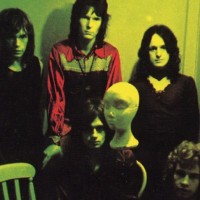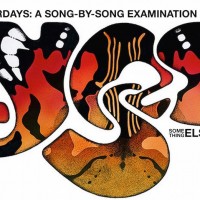The Yes Album, released this week in 1971, was Yes’ big-bang moment, a project where the full scope of their looming genius began to take shape. It was also a critical junction point, as Steve Howe replaced late guitarist Peter Banks, while fellow co-founder Tony Kaye took a final bow.
Those shifting foundational elements only added to the flinty inventiveness of these sessions, which retained several key elements of Yes’ earliest efforts (Chris Squire’s melodic then pulverizing bass, these gorgeous close harmonies, Jon Anderson’s impish, endlessly imaginative imagery) even as it rapidly widened their musical vocabulary. Howe arrived as an eruptively creative force, stirring in guitar textures that hurtled Yes toward new vistas — and underrated lyrical contributions that added contextual weight.
The bulk of The Yes Album was written away from the London city center, before recording commenced at Advision Studios. (Howe’s “Clap,” meanwhile, emerged from a July 1970 performance at the Lyceum Theatre.) Free of those bustling environs, every member of Yes was moved to contribute musical ideas — and they were in turn given an expanded canvas on The Yes Album, issued on February 19, 1971.
“We’d done the first two albums — Yes and Time and a Word — with Peter,” Kaye tells us, in an exclusive Something Else! Sitdown. “And as he left the band, we were starting to get a little bit of a reputation after playing around England. I was pretty much a resident of the Speakeasy, our local London watering hole, and saw Steve Howe with his band Bodast. I talked to Steve, and brought him into the band and pretty soon, we went down to a little cottage in Devon and started writing The Yes Album. It was a big change, with Peter leaving and Steve coming in. We set up a room to rehearse, and we basically lived there. We started writing little bits, and everybody brought in their own things. It was a gradual, building thing.”
“Yours is No Disgrace,” the album’s opening — and lengthiest — cut signals the full complexity of what’s to come for a band that would soon be constructing tracks that stretched across entire album sides. The track, which thumps along behind a chugging organ courtesy of co-writer Tony Kaye, casts a hardened gaze on the idea of war — even as it moves through a series of episodic narrative twists.
That it would represent one of Tony Kaye’s last important contributions to the group’s early period was then unclear. Jon Anderson tells us that, during a period of such dizzying growth, Kaye’s focus on the conventional things like the B-3 simply didn’t give Yes enough creative flexibility.
“Tony Kaye was amazing over the first three albums,” Anderson says. “It was just a question of having someone in the band who was willing to try different keyboard sounds. Tony was very: ‘I want to play the piano and the organ; that’s my thing.’ When we tried to push him into different sounds, he wasn’t really eager to do it. You don’t want to force anybody to do anything.”
There was simply too much ground to cover, as Yes took an ever-more adventurous course. Steve Howe’s Chet Atkins-inspired solo piece “Clap” led to the three-segment “Starship Trooper,” which concludes a towering cadenza that the guitarist arrived with from his time in Bodast, titled “Wurm.” Combined with Howe’s inventive opening statement on “Yours is No Disgrace,” the guitarist had already established a broad new musical palette. There was simply no stopping Yes’ roving creativity at this point.
“I wanted to bring in some fresh and subtle sounds with Yes, sounds that were more celestial,” Steve Howe tells us, in a separate Something Else! Sitdown. “Obviously, what I was really fighting — this is quite interesting — was the incessant influence of electric blues guitar in rock ‘n’ roll. I love Eric Clapton, but that was my main goal. I was going to come in here and do something that had nothing to do with that whatsoever. Big Bill Broonzy is one of my favorite blues guitarists, and he was strictly acoustic. So what I was saying to the world, secretly, was that country blues was far more influential than the city blues.”
Howe added a delicate Portuguese guitar to “I’ve Seen All Good People,” before The Yes Album concludes with Jon Anderson’s “A Venture” — featuring a jazzy turn at piano by Tony Kaye — and then “Perpetual Change,” which makes a more direct reference to the bucolic environs of their initial writing sessions before hurtling into a moment of polyrhythmic brilliance from Chris Squire.
More than simply setting the stage for subsequent artistic-highpoint releases like 1971’s Fragile and 1972’s Close to the Edge, this album established every parameter that the band would one day inhabit: Sweeping in scope, Yes could be classically inspired, invitingly utopian and in no small way funky — sometimes all in one song.
The public responded, making this project Yes’ long-awaited commercial breakthrough. A No. 4 smash in the UK, The Yes Album became Yes’ first-ever Top 40 entry in America, and has gone on to platinum-selling status. “I’ve Seen All Good People,” “Yours Is No Disgrace” and “Starship Trooper” became concert staples, even as Rick Wakeman — a cape-wearing multi-synth genius — took over for Kaye.
“It turned out to be the breaking album for the band,” Tony Kaye adds. “It was a special time. It was just one of those moments where you finally knew what you were doing, and got it together in one place — outside of London, in a very quiet atmosphere. It came together, and it was a pretty important album.”
- Nick DeRiso’s Best of 2015 (Rock + Pop): Death Cab for Cutie, Joe Jackson, Toto + Others - January 18, 2016
- Nick DeRiso’s Best of 2015 (Blues, Jazz + R&B): Boz Scaggs, Gavin Harrison, Alabama Shakes - January 10, 2016
- Nick DeRiso’s Best of 2015 (Reissues + Live): John Oates, Led Zeppelin, Yes, Faces + others - January 7, 2016




No (mention of the) contribution from Bill Bruford?
One can tell this album is the start of the Yes trademark sound and is a remarkable piece of music!